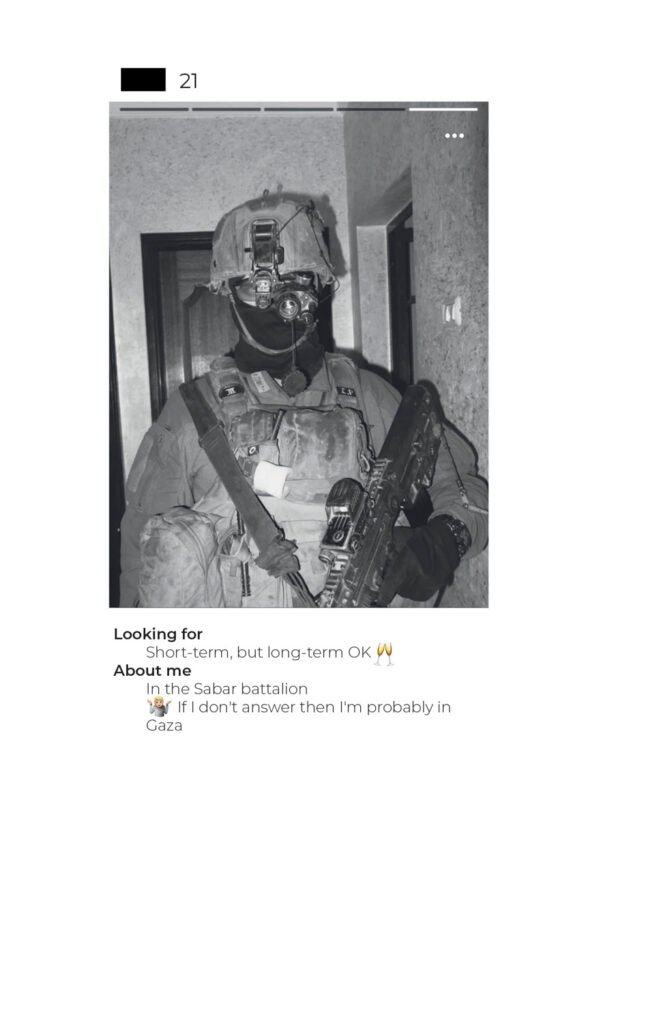FEDERICO VESPIGNANI
Short-term, But Long-Term
published by: Debatable Publishing
Selected from GETXOPHOTO
→ info
“Short-term, But Long-Term 🥂 ” is based on over 300 images compiled, redacted, and appropriated via dating apps.
Heterosexual male combatants of the Israel Defence Force took the photographs and shared them while they were operating in the Gaza Strip in 2024.
During the ongoing military operation conducted by the IDF in the wake of the terrorist attack of October 7, 2023, there has been a widespread online presence of videos and images recorded by members of the IDF documenting themselves, often committing various degrees of crimes.
Social media has changed the way the Western audience perceives wars. There has been a movement from professional media operators towards more intimate raw footage captured and published by individual soldiers on the ground. This trend has enabled social media platforms to be a new venue for the image of war. Therefore, these visual narratives serve as legitimization tools for military practices.
In this context, combatants have always prioritized war reality over civilians. In popular belief, the military term “ground truths, ” which refers to soldiers’ experiences near violence, is the most truthful account of the realities of war.
The diffuse trend by IDF male soldiers to publish war imagery on dating apps reflects, above all, a kind of cultural militarism within Israeli society and a process of erotic militarization. The images, often in the form of environmental portraits, have a sense of truth and immediacy. The male soldiers appear morally good and masculine. Sometimes, they frame their weaponry, and we see the result of their use in Gaza as a scorched earth landscape. When they pose inside civilian homes, we see traces of what these houses used to be among the debris.
This narrative illustrates how they wield violence to protect their homeland, with the symbolic importance of their bodies serving to legitimize this violence to female viewers. This dynamic appeals to a shared sense of identity and emotion, deepening the connection between the characters and their audience. Within this supremacist worldview, the glorification of some bodies depends on the destruction of others.
Born in Venice (1988) – Federico Vespignani is a photographer and cinematographer.
His editorial works have been published in leading international outlets such as The New York Times, GEO, Stern, Courrier International, Monocle, Domus, Society, Forbes, Bloomberg, and D la Repubblica.
His research focuses on a visual discourse on transnational crime, state-sponsored propaganda, and environmental collapse, emphasizing the role of visual culture in shaping public perception. He is also a co-founder of Celestia Studio, a multidisciplinary visual studio based in Venice.
Getxophoto is an image festival created and managed by Begihandi, that has been taking place in Getxo—Basque Country, Euskadi—since 2007. This festival is part of a cultural ecosystem with the aim of being more participatory, hybrid, committed and sustainable. This thematic Festival is conceived as a platform that addresses contemporary challenges through different proposals, from visual storytellers around the world, in an attempt to create spaces for reflection and establish a collective conversation. Getxophoto is characterized by the radical defense of public space (both physical and online). For this reason, most of its programme is composed of outdoor installations, highlighting, on the one hand, the link between the image and the environment and, on the other, generating a more horizontal and participatory relationship with the public.
This year, after PAUSE and PLAY, the festival will take the theme: REC. The abbreviation for Record, which usually appears as a red circle on our screens, refers to a register, to memory, to the story of the past, and to images as a witness to reality. The relationship between image and record is a central debate in visual studies, one that has been addressed by the great names of the theory of photography such as Walter Benjamin, Susan Sontag and Georges Didi-Huberman. But what is left of this debate today in relation to contemporary technologies? What is the difference between accumulating archives and telling a story? What is the future of the image—and of memory constructed through visual recording—in a world of extreme, immaterial, manipulable and seemingly infinite REC?
María Ptqk is the curator of GETXOPHOTO 2025.















